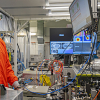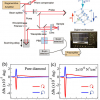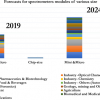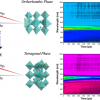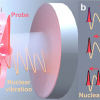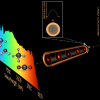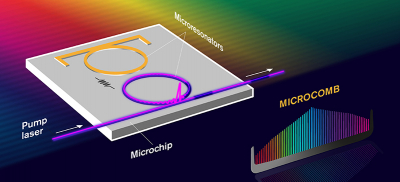
A microcomb is a photonic device capable of generating a myriad of optical frequencies on a tiny cavity known as microresonator. The frequencies are uniformly distributed, and the device can be used to measure or generate frequencies with extreme precision. Researchers from Chalmers University of Technology have described a new kind of microcomb on a chip, based on two microresonators. The new microcomb is a coherent, tuneable and reproducible device with up to ten times higher net conversion efficiency than the current state of the art.
“The reason why the results are important is that they represent a unique combination of characteristics, in terms of efficiency, low-power operation and control, that are unprecedented in the field”, says Óskar Bjarki Helgason, a PhD student at the Department of Microtechnology and Nanoscience at Chalmers.
The Chalmers researchers are not the first to demonstrate a microcomb on a chip, but they have developed a method that overcomes several well-known limitations in the field. The key factor is the use of two microresonators instead of one. This arrangement results in the unique physical characteristics.
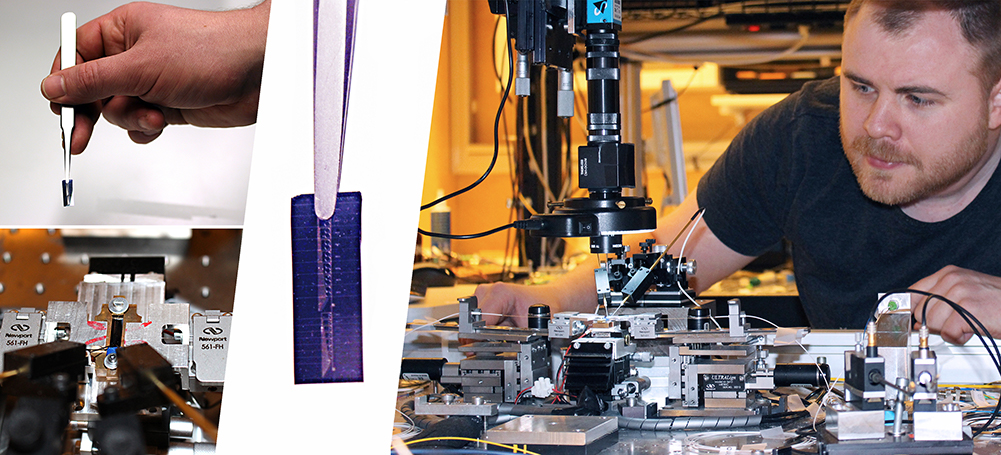
The Photonics Laboratory at Chalmers. PhD Student Óskar Bjarki Helgason demonstrates the chip and the experimental setup for generating the game changing microcomb. Photo: Mia Halleröd Palmgren; Collage: Yen Strandqvist/Chalmers
The microcombs offer a wide range of potential applications, from radically decreasing the power consumption in optical communication systems, to use in lidar for autonomous driving vehicles and in the calibration of the spectrographs used in astronomical observatories devoted to the discovery of Earth-like exoplanets.
“For the technology to be practical and find its use outside the lab, we need to co-integrate additional elements with the microresonators, such as lasers, modulators and control electronics. This is a huge challenge, that requires maybe 5–10 years and an investment in engineering research. But I am convinced that it will happen”, says Victor Torres Company, who leads the research project at Chalmers. He continues:
“The most interesting advances and applications are the ones that we have not even conceived of yet. This will likely be enabled by the possibility of having multiple microcombs on the same chip. What could we achieve with tens of microcombs that we cannot do with one?”
What are frequency combs and microcombs?
A frequency comb is a special laser where the emission frequencies are evenly spaced. It functions as a ruler made of light, where the markers set the frequency scale across a portion of the electromagnetic spectrum, from the ultraviolet to the mid-infrared. The location of the markers can be linked to a known reference. This was achieved in the late 1990s, and it signified a revolution in precision metrology—an achievement recognised by the Nobel Prize in Physics in 2005.
A microcomb is a modern, alternative technology to mode-locked lasers, that can generate repetitive pulses of light at astonishing rates. They are generated by sending laser light to a tiny optical cavity called a microresonator. Thus, microcombs have two important attributes that make them extremely attractive for practical purposes: the frequency spacing between markers is very large (typically between 10 GHz and 1000 GHz), that is much higher than the spacing in mode-locked laser frequency combs, and they can be implemented with photonic integration technology. The compatibility with photonic integration brings benefits in terms of reduction of size, power consumption and the possibility to reach mass-market applications. The large spacing between teeth means that microcombs can be used for novel applications, such as light sources for fibre-optic communication systems or for the synthesis of pure microwave electromagnetic radiation.
The key to the new enhanced microcomb from Chalmers is that the researchers have used two microresonators instead of one. The microresonators interact with each other, similar to how atoms bind together when forming a diatomic molecule. This arrangement is known as a photonic molecule and has unique physical characteristics.
Watch a video recording from the lab: How to generate the microcomb:
PhD student Óskar Bjarki Helgason at Chalmers University of Technology, Sweden, demonstrates the experimental setup in the lab and explains how the new microcomb is generated.





